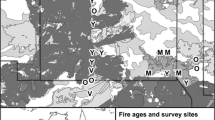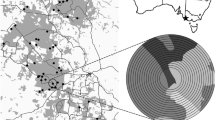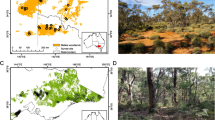Abstract
Context
Multiple ecological drivers generate spatial patterns in species’ distributions. Changes to natural disturbance regimes can place early successional habitat specialists at an increased risk of extinction by altering landscape patterns of habitat suitability.
Objectives
We developed a series of hypotheses to evaluate the effects of landscape structure, fire history, and site-level habitat quality on site occupancy by an early successional specialist, the eastern chestnut mouse (Pseudomys gracilicaudatus).
Methods
We obtained eight years of monitoring data from 26 sites in recently burned heathland in southeast Australia. We used generalised linear models to determine which explanatory variables were related to occupancy. We also explored predictability in patterns of small mammal species co-occurrence.
Results
Landscape structure (patch area, landscape heterogeneity) was strongly related to site occupancy. Site occupancy was associated with dead shrubs in the understory and rock cover on ground layer, but was not directly influenced by recent or historical fire. Contrary to contemporary ecological theory, we found no predictable species associations in our early successional community.
Conclusions
We recommend surveys take account of landscape configuration and proximity to suitable habitat for optimal results. Fire regimes expected to promote eastern chestnut mouse population growth should encourage the retention of critical habitat features rather than be based on temporal rates of successional stages. For management to adequately account for post-disturbance patterns in early successional communities, a species-by-species, multi-scaled approach to research is necessary.





Similar content being viewed by others
References
Baker J, Whelan RJ, Evans L, Moore S, Norton M (2010) Managing the ground parrot in its fiery habitat in south-eastern Australia. Emu 110:279–284
Banks SC, Finlayson GR, Lawson SJ, Lindenmayer DB, Paetkau D, Ward SJ, Taylor AC (2005a) The effects of habitat fragmentation due to forestry plantation establishment on the demography and genetic variation of a marsupial carnivore, Antechinus agilis. Biol Conserv 122:581–597
Banks SC, Ward SJ, Lindenmayer DB, Finlayson GR, Lawson SJ, Taylor AC (2005b) The effects of habitat fragmentation on the social kin structure and mating system of the agile antechinus, Antechinus agilis. Mol Ecol 14:1789–1801
Banks SC, Dujardin M, McBurney L, Blair D, Barker M, Lindenmayer DB (2011) Starting points for small mammal population recovery after wildfire: recolonisation or residual populations? Oikos 120:26–37
Banks SC, Cary GJ, Smith AL, Driscoll DA, Lindenmayer DB, Davies ID, Gill AM, Peakall R (2013) How does ecological disturbance influence genetic diversity? Trends Ecol Evol 28:670–679
Bradstock RA, Williams J, Gill AM (eds) (2012) Flammable Australia: the fire regimes and biodiversity of a continent. Cambridge University Press, Cambridge
Braithwaite RW (1982) Small marginal groups of Rattus lutreolus in good and poor habitat. J Zool 198:529–532
Breed B, Ford F (2007) Native mice and rats. CSIRO Publishing, Collingwood
Burel F, Baudry J (2003) Landscape ecology: concepts, methods and applications. Science Publishers, Enfield
Burnham KP, Anderson DR (2002) Model selection and multi-modal inference: a practical information-theoretic approach. Springer, New York
Catling PC (1986) Rattus lutreolus, colonizer of heathland after fire in the absence of Pseudomys species. Aust Wildl Res 13:127–139
Catling PC (1991) Ecological effects of prescribed burning practices on the mammals of southeastern Australia. In: Lunney D (ed) Conservation of Australia’s forest fauna. Royal Zoological Society of NSW, NSW, pp 353–363
Chesson P (2000) Mechanisms of maintenance of species diversity. Annu Rev Ecol Syst 31:343–366
Cockburn A (1978) Distribution of Pseudomys shortridgei (Muridae: Rodentia) and its relevance to that of other heathland Pseudomys. Aust Wildl Res 5:213–219
Cockburn A (1981) Diet and habitat preference of the silky desert mouse Pseudomys apodemoides (Rodentia). Aust Wildl Res 8:475–497
Cockburn A, Lazenby-Cohen KA (1992) Use of nest trees by Antechinus stuartii, a semelparous lekking marsupial. J Zool London 226:657–680
Cockburn A, Braithwaite RW, Lee AK (1981) The response of the heath rat, Pseudomys shortridgei, to pyric succession—a temporally dynamic life-history strategy. J Anim Ecol 50:649–666
Connell JH, Slatyer RO (1977) Mechanisms of succession in natural communities and their role in community stability and organization. Am Nat 111:1119–1144
Conover WJ (1999) Practical nonparametric statistics, 3rd edn. Wiley, New York
Crowther MS (2002) Distributions of species of the Antechinus stuartii-A. flavipes complex as predicted by bioclimatic modelling. Aust J Zool 50:77–91
Crowther MS, Braithwaite RW (2008) Brown antechinus, Antechinus stuartii. In: Van Dyck S, Strahan R (eds) The mammals of Australia. Reed New Holland, Sydney, pp 94–96
Delmoral R, Bliss LC (1993) Mechanisms of primary succession: insights resulting from the eruption of Mount St Helens. Adv Ecol Res 24:1–66
Di Stefano J, Owen L, Morris R, Duff T, York A (2011) Fire, landscape change and models of small mammal habitat suitability at multiple spatial scales. Aust Ecol 36:638–649
Dickman CR (2008) Agile antechinus, Antechinus agilis. In: Van Dyck S, Strahan R (eds) The mammals of Australia. Reed New Holland, Sydney, pp 83–84
Driscoll DA, Henderson MK (2008) How many common reptile species are fire specialists? A replicated natural experiment highlights the predictive weakness of a fire succession model. Biol Conserv 141:460–471
ESRI 2009. ArcMap 9.2. Environmental Systems Resource Institute, California
Fox BJ (1982) Fire and mammalian secondary succession in an Australian coastal heath. Ecology 63:1332–1341
Fox BJ (2008) Eastern chestnut mouse, Pseudomys gracilicaudatus. In: Van Dyck S, Strahan R (eds) The mammals of Australia. Reed New Holland, Sydney, pp 634–635
Fox BJ, Archer E (1984) The diets of Sminthopsis murina and Antechinus stuartii (Marsupialia: Dasyuridae) in sympatry. Aust Wildl Res 11:235–248
Fox BJ, Kemper CM (1982) Growth and development of Pseudomys gracilicaudatus (Rodentia: Muridae) in the laboratory. Aust J Zool 30:175–185
Fox BJ, Taylor JE, Thompson PT (2003) Experimental manipulation of habitat structure: a retrogression of the small mammal succession. J Anim Ecol 72:927–940
Franklin JF, Lindenmayer D, MacMahon JA, McKee A, Magnuson J, Perry DA, Waide R, Foster D (2000) Threads of continuity. Conserv Pract 1:8–17
Gill AM, Allan G (2008) Large fires, fire effects and the fire-regime concept. Intern J Wildl Fire 17:688–695
Higgs P, Fox BJ (1993) Interspecific competition: a mechanism for rodent succession after fire in wet heathland. Aust J Ecol 18:193–201
Hutto RL (2008) The ecological importance of severe wildfires: some like it hot. Ecol Appl 18:1827–1834
Keith DA, McCaw WL, Whelan RJ (2002) Fire regimes in Australian heathlands and their effects on plants and animals. In: Bradstock RA, Williams JE, Gill AM (eds) Flammable Australia: the fire regimes and biodiversity of a continent. Cambridge University Press, New York, pp 199–237
Lee Y, Nelder JA, Pawitan Y (2006) Generalized linear models with random effects: unified analysis via h-likelihood. Chapman & Hall/CRC, Boca Raton
Letnic M, Dickman CR (2005) The responses of small mammals to patches regenerating after fire and rainfall in the Simpson Desert, central Australia. Aust Ecol 30:24–39
Letnic M, Dickman CR, Tischler MK, Tamayo B, Beh CL (2004) The responses of small mammals and lizards to post-fire succession and rainfall in arid Australia. J Arid Environ 59:85–114
Letnic M, Tischler M, Gordon C (2013) Desert small mammal responses to wildfire and predation in the aftermath of a La Nina driven resource pulse. Aust Ecol 38:841
Levin SA (1992) The problem of pattern and scale in ecology: the Robert H. MacArthur award lecture. Ecology 73:1943–1967
Lindenmayer DB, Cunningham RB, Peakall R (2005) The recovery of populations of bush rat Rattus fuscipes in forest fragments following major population reduction. J Appl Ecol 42:649–658
Lindenmayer DB, MacGregor C, Welsh A, Donnelly C, Crane M, Michael D, Montague-Drake R, Cunningham RB, Brown D, Fortescue M, Dexter N, Hudson M, Gill AM (2008a) Contrasting mammal responses to vegetation type and fire. Wildl Res 35:395–408
Lindenmayer DB, Wood JT, MacGregor C, Michael DR, Cunningham RB, Crane M, Montague-Drake R, Brown D, Muntz R, Driscoll DA (2008b) How predictable are reptile responses to wildfire? Oikos 117:1086–1097
Lindenmayer DB, MacGregor C, Wood JT, Cunningham RB, Crane M, Michael D, Montague-Drake R, Brown D, Fortescue M, Dexter N, Hudson M, Gill AM (2009) What factors influence rapid post-fire site re-occupancy? A case study of the endangered eastern bristlebird in eastern Australia. Intern J Wildl Fire 18:84–95
Lunney D (2008a) Bush rat, Rattus fuscipes. In: Van Dyck S, Strahan R (eds) The mammals of Australia. Reed New Holland, Sydney, pp 685–687
Lunney D (2008b) Swamp rat, Rattus lutreolus. In: Van Dyck S, Strahan R (eds) The mammals of Australia. Reed New Holland, Sydney, pp 690–692
Luo JIA, Fox BJ (1996) Seasonal and successional dietary shifts of two sympatric rodents in coastal heathland: a possible mechanism for coexistence. Aust Ecol 21:121–132
Luo J, Fox BJ, Jefferys E (1994) Diet of the Eastern Chestnut Mouse (Pseudomys gracilicaudatus) I composition, diversity and individual variation. Wildl Res 21:401–417
MacArthur RH, Wilson EO (1967) The theory of island biogeography. Princeton University Press, New Jersey
Masters P (1993) The effects of fire driven succession and rainfall on small mammals in spinifex grassland at Uluru National Park, Northern Territory. Wildl Res 20:803–813
McCarthy MA, Gill AM, Lindenmayer DB (1999) Fire regimes in mountain ash forest: evidence from forest age structure, extinction models and wildlife habitat. For Ecol Manage 124:193–203
McCullagh P, Nelder JA (1989) Generalized linear models. Chapman and Hall, New York
Monamy V, Fox BJ (2000) Small mammal succession is determined by vegetation density rather than time elapsed since disturbance. Aust Ecol 25:580–587
Monamy V, Fox BJ (2010) Responses of two species of heathland rodents to habitat manipulation: vegetation density thresholds and the habitat accommodation model. Aust Ecol 35:334–347
Newsome AE, McIlroy J, Catling PC (1975) The effects of an extensive wildfire on populations of twenty ground vertebrates in southeast Australia. Proc Ecol Soc Aust 9:107–123
Pereoglou F, MacGregor C, Banks SC, Ford FD, Wood JT, Lindenmayer DB (2011) Refuge site selection by the eastern chestnut mouse in recently burned heath. Wildl Res 38:290–298
Pereoglou F, Lindenmayer DB, MacGregor C, Ford F, Wood J, Banks SC (2013) Landscape genetics of an early successional specialist in a disturbance-prone environment. Mol Ecol 22:1267–1281
Peterson GD (2002) Contagious disturbance, ecological memory, and the emergence of landscape pattern. Ecosystems 5:329–338
Pickett STA, White PS (eds) (1985) The ecology of natural disturbance and patch dynamics. Academic Press Inc, Florida
Prugh LR, Hodges KE, Sinclair ARE, Brashares JS (2008) Effect of habitat area and isolation on fragmented animal populations. Proc Natl Acad Sci 105:20770–20775
Robinson AC (1987) The ecology of the bush rat, Rattus fuscipes (Rodentia: Muridae), in Sherbrooke Forest, Victoria. Aust Mammal 11:35–49
Robinson NM, Leonard SWJ, Ritchie EG, Bassett M, Chia EK, Buckingham S, Gibb H, Bennett AF, Clarke MF (2013) Refuges for fauna in fire-prone landscapes: their ecological function and importance. J Appl Ecol 50:1321–1329
Rossi F, Forster RM, Montserrat F, Ponti M, Terlizzi A, Ysebaert T, Middelburg JJ (2007) Human trampling as short-term disturbance on intertidal mudflats: effects on macrofauna biodiversity and population dynamics of bivalves. Mar Biol 151:2077–2090
Rota CT, Millspaugh JJ, Rumble MA, Lehman CP, Kesler DC (2014) The role of wildfire, prescribed fire, and mountain pine beetle infestations on the population dynamics of black-backed woodpeckers in the Black Hills, South Dakota. PLoS ONE 9:e94700
Schwarz G (1978) Estimating the dimension of a model. Ann Stat 6:461–464
Sousa WP (1979) Disturbance in intertidal boulder fields: the non-equilibrium maintenance of species diversity. Ecology 60:1225–1239
Specht RL (1981) Responses to fire in heathlands and related shrublands. In: Gill AM, Groves RH, Noble IR (eds) Fire and the Australian biota. Australian Academy of Science, Canberra, pp 395–415
Swanson ME, Franklin JF, Beschta RL, Crisafulli CM, DellaSala DA, Hutto RL, Lindenmayer DB, Swanson FJ (2011) The forgotten stage of forest succession: early-successional ecosystems on forest sites. Front Ecol Environ 9:117–125
Taws N (1997) Vegetation survey and mapping of Jervis Bay Territory. Report, Canberra
Templeton AR, Brazeal H, Neuwald JL (2011) The transition from isolated patches to a metapopulation in the eastern collared lizard in response to prescribed fires. Ecology 92:1736–1747
Thomas CD (1994) Extinction, colonization, and metapopulations: environmental tracking by rare species. Conserv Biol 8:373–378
Thomas CD, Thomas JA, Warren MS (1992) Distributions of occupied and vacant butterfly habitats in fragmented landscapes. Oecologia 92:563–567
Thornton DH, Branch LC, Sunquist ME (2011) The influence of landscape, patch, and with-in patch factors on species presence and abundance: a review of focal patch studies. Landscape Ecol 26:7–18
Townley SJ (2000) The ecology of the Hastings River mouse Pseudomys oralis (Rodentia: Muridae) in northeastern New South Wales and southeastern Queensland. PhD, Southern Cross University, Lismore
Turner MG (1989) Landscape ecology: the effect of pattern on process. Annu Rev Ecol Syst 20:171–197
Turner MG (2005) Landscape ecology: what is the state of the science. Annu Rev Ecol Syst 36:319–344
Turner MG, Baker WL, Peterson CJ, Peet RK (1998) Factors influencing succession: lessons from large, infrequent natural disturbances. Ecosystems 1:511–523
Velle LG, Vandvik V (2014) Succession after prescribed burning in coastal Calluna heathlands along a 340-km latitudinal gradient. J Veg Sci 25:546–558
Vieira EM, Briani DC (2013) Short-term effects of fire on small rodents in the Brazillian Cerrad and their relation with feeding habits. International Journal of Wildland Fire. 22:1063–1071
Warneke RM (1971) Field study of the bush rat (Rattus fuscipes). Wildl Contrib Vic 14:1–115
Watson SJ, Taylor RS, Nimmo DG, Kelly LT, Clarke MF, Bennett AF (2012) The influence of unburnt patches and distance from refuges on post-fire bird communities. Anim Conserv 15:499–507
Watts CHS, Aslin HJ (1981) The rodents of Australia. Angus & Robertson Publishers, Sydney
Whelan RJ (1995) The ecology of fire. Cambridge University Press, Cambridge
Whelan RJ, Rodgerson L, Dickman CR, Sutherland EF (2002) Critical life cycles of plants and animals: developing a process-based understanding of population changes in fire-prone landscapes. In: Bradstock RA, Williams JE, Gill AM (eds) Flammable Australia: the fire regimes and biodiversity of a continent. Cambridge University Press, New York, pp 94–124
Williams DG (1995) Heaths and scrubs. In: Cho G, Georges A, Stoutjesdijk R, Longmore R (eds) Jervis Bay. A place of cultural, scientific and educational value. Kowari 5. Australian Nature Conservation Agency, Canberra, pp 83–90
Acknowledgments
We most gratefully acknowledge the Wreck Bay Aboriginal Community and the Wandandian People of the Dharawal and Dhurga language groups on whose lands this study was conducted. Mason Crane, Damien Michael, Rebecca Montague-Drake, and Sachiko Okada provided fieldwork assistance. This project is part of a major study in Booderee National Park funded by the Australian Research Council, the Department of Environment and Water Resources and the Department of Defence.
Author information
Authors and Affiliations
Corresponding author
Electronic supplementary material
Below is the link to the electronic supplementary material.
Rights and permissions
About this article
Cite this article
Pereoglou, F., MacGregor, C., Banks, S.C. et al. Landscape, fire and habitat: which features of recently burned heathland influence site occupancy of an early successional specialist?. Landscape Ecol 31, 255–269 (2016). https://doi.org/10.1007/s10980-015-0240-2
Received:
Accepted:
Published:
Issue Date:
DOI: https://doi.org/10.1007/s10980-015-0240-2




